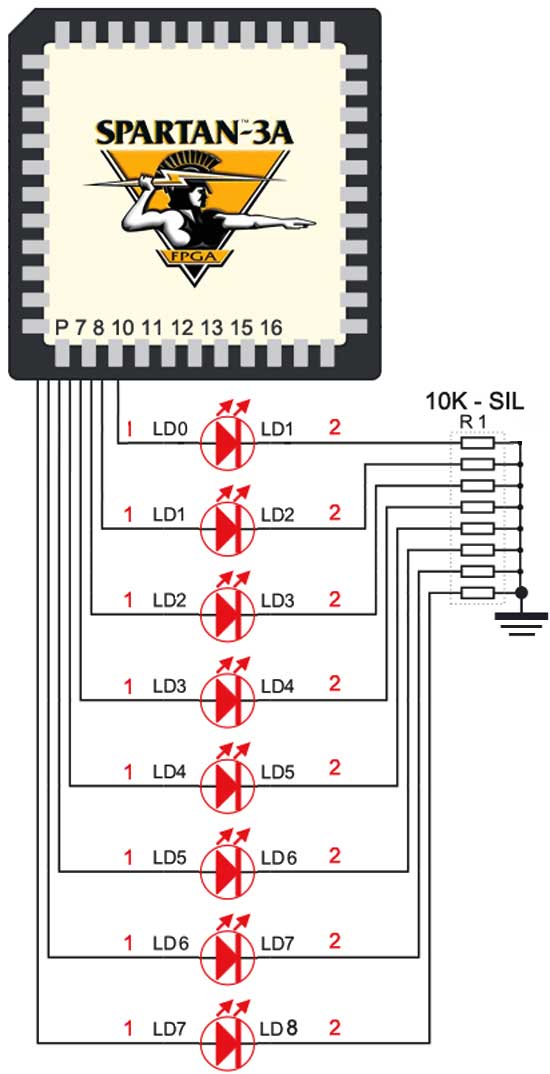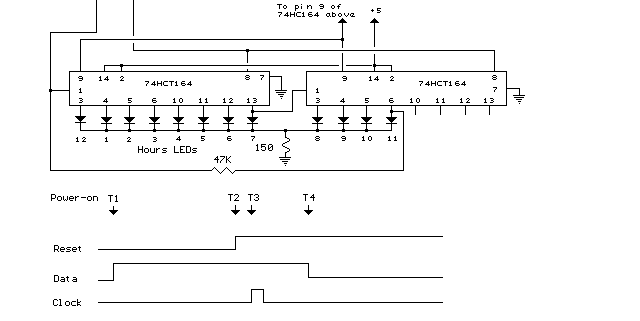
how to interface led with spartan 3an

The Spartan-3an board features eight LEDs connected to FPGA I/O pins. The cathode of each LED is connected to ground through a 330-ohm resistor. To illuminate a specific LED, the corresponding FPGA control signal must be set to High.
The Spartan-3an board is designed for integration with various digital systems, leveraging its FPGA capabilities to control the eight LEDs. Each LED serves as an output indicator, providing visual feedback based on the state of the FPGA control signals.
The configuration involves connecting the anodes of the LEDs to designated I/O pins on the FPGA. Each LED's cathode is linked to ground through a 330-ohm resistor, which limits the current flowing through the LED, thereby preventing damage from excessive current. The choice of a 330-ohm resistor is typical for standard 5V supply LEDs, ensuring adequate brightness while maintaining safe operating conditions.
To activate an LED, the associated I/O pin must be driven to a High state (logic level 1), which allows current to flow from the power supply through the LED and the resistor to ground. Conversely, driving the I/O pin to a Low state (logic level 0) turns the LED off, as no current flows through the circuit.
This setup is commonly utilized in educational and prototyping environments, allowing users to experiment with digital logic and FPGA programming. The straightforward nature of the LED control mechanism makes it an excellent starting point for understanding more complex digital systems and FPGA applications.The Spartan-3an board has eight LED Connected with FPGA I/O pins (details tabulated below). The cathode of each LED connects to ground via a 330 © resistor. To light an individual LED, drive the associated FPGA control signal to High. 🔗 External reference
The Spartan-3an board is designed for integration with various digital systems, leveraging its FPGA capabilities to control the eight LEDs. Each LED serves as an output indicator, providing visual feedback based on the state of the FPGA control signals.
The configuration involves connecting the anodes of the LEDs to designated I/O pins on the FPGA. Each LED's cathode is linked to ground through a 330-ohm resistor, which limits the current flowing through the LED, thereby preventing damage from excessive current. The choice of a 330-ohm resistor is typical for standard 5V supply LEDs, ensuring adequate brightness while maintaining safe operating conditions.
To activate an LED, the associated I/O pin must be driven to a High state (logic level 1), which allows current to flow from the power supply through the LED and the resistor to ground. Conversely, driving the I/O pin to a Low state (logic level 0) turns the LED off, as no current flows through the circuit.
This setup is commonly utilized in educational and prototyping environments, allowing users to experiment with digital logic and FPGA programming. The straightforward nature of the LED control mechanism makes it an excellent starting point for understanding more complex digital systems and FPGA applications.The Spartan-3an board has eight LED Connected with FPGA I/O pins (details tabulated below). The cathode of each LED connects to ground via a 330 © resistor. To light an individual LED, drive the associated FPGA control signal to High. 🔗 External reference
Warning: include(partials/cookie-banner.php): Failed to open stream: Permission denied in /var/www/html/nextgr/view-circuit.php on line 713
Warning: include(): Failed opening 'partials/cookie-banner.php' for inclusion (include_path='.:/usr/share/php') in /var/www/html/nextgr/view-circuit.php on line 713





